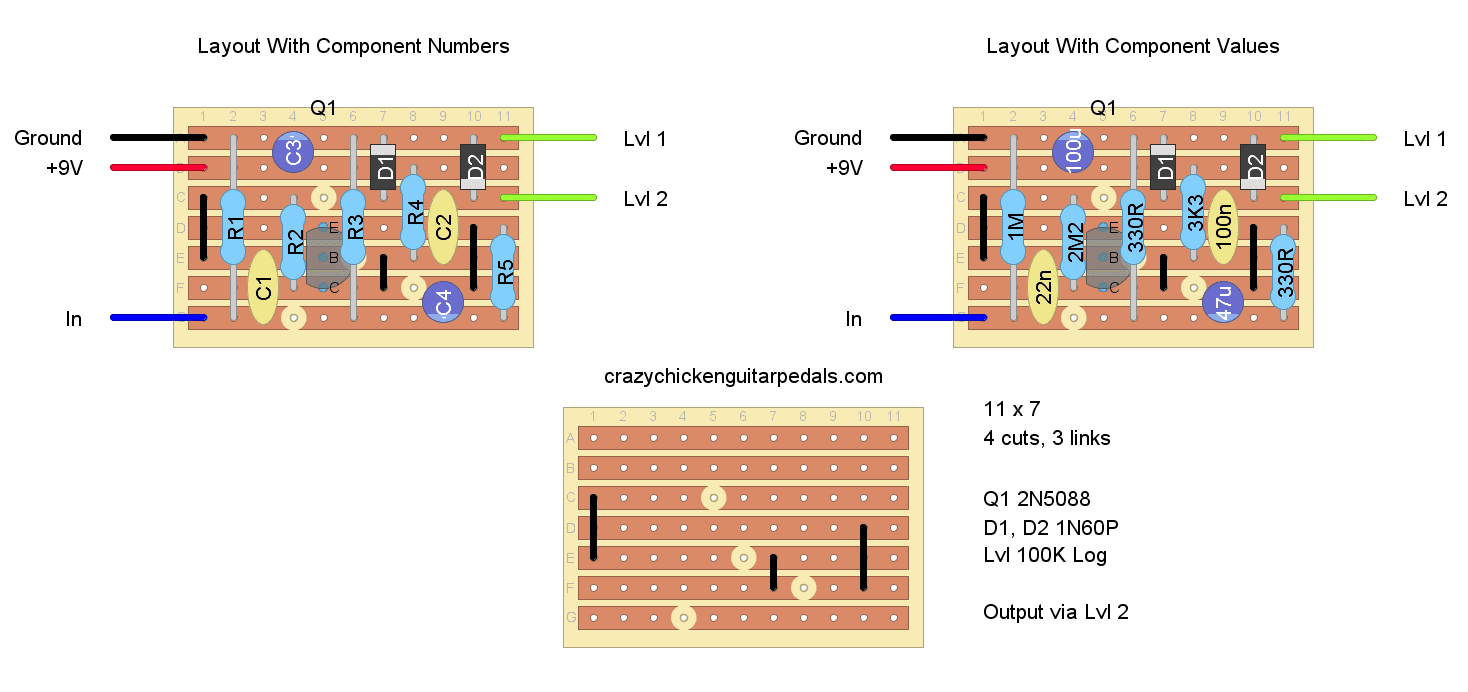It’s been awhile since I’ve built anything,so it was nice to get back into my workshop and build this awesome little pedal: the Champ by Lovepedal. There’s quite a few pedals I want to build (or build again to give to friends), but I’ve been working my way through my list of easy to build DIY guitar pedals because they’re fun to make and I want to provide a resource for beginners. Unfortunately it’s been mighty cold where I am, making it a lot less fun to be in my garage workshop. It’s still the middle of winter, but on a sunny afternoon it’s not too bad, so I took the opportunity to do a new pedal build.
And I’m really glad I did, because not only was this a fun build, it sounds great!
The Lovepedal Champ is a simple guitar pedal with just one knob, and that knob does nothing except control the volume. The pedal itself is designed to sound like a Fender Champ amplifier pushed to its limits, bringing all of the tone that it has to offer.
While that may sound like an odd pedal to design, wait until you hear this thing. Or just read Lovepedal’s description on their website. A (good) tube amp pushed to its limits always sounds great, and a Fender Champ is no different. According to Lovepedal, a Champ was used by Eric Clapton to record Layla and by ZZ Top to record La Grange. Not bad for a practice amp… But the tone in these two songs was only achieved by absolutely cranking the thing. And, even if you already have a vintage Champ handy, your neighbours don’t always want you making all that noise.
That’s what the Lovepedal Champ is for: get the tone of a Champ but at lower volumes.
Lovepedal Champ Wiring Schematic
Feel free to jump ahead to the stripboard layout, but if you’re curious about the schematic for this fine little pedal, here it is.
Click on the schematic to enlarge it.
And here’s the bill of materials.
| Notes | ||
|---|---|---|
| R1 | 1M | |
| R2 | 2M2 | |
| R3 | 330R | |
| R4 | 3K3 | |
| R5 | 330R | |
| C1 | 22nF | |
| C2 | 100nF | |
| C3 | 100uF | |
| C4 | 47uF | |
| Q1 | 2N5088 | |
| P1 | 100K Log | Level potentiometer |
| D1, D2 | 1N60P | |
| Jacks, power supply, etc. | Don't Forget | The stuff you usually use. |
Like so many of Lovepedal’s circuits, they’re using the Electra Distortion circuit as the basis for this pedal. I haven’t looked at every Lovepedal schematic, but the handful I’ve seen use the Electra Distortion circuit as a base. And I wasn’t the first to notice this. It’s a great little distortion circuit that’s easy to make, works well, and sounds fantastic. And it can sound wildly different just by swapping out some components. This wasn’t the first Electra Distortion circuit I’ve made, and I’m sure it won’t be the last.
From looking at the schematic, it’s apparent that this is a relatively transparent pedal. The final 100n transistor combined with the volume pot will create a high pass filter situation, but other than that there’s nothing else going on here tone-wise.
To that end, what’s there to change here? I would say don’t change anything. The Lovepedal Champ is just a modified version of the Electra Distortion circuit, so if you are looking to do mods, go back to the original and build it from there. Changing up the transistor or the diodes will change the sound and, as mentioned, changing up the value of that final capacitor will change the tone. But, since it’s such a simple circuit, I would say you’re starting to get into “new pedal design” territory rather than “modified pedal” territory, even with those small changes. But that’s just my opinion.
Lovepedal Champ Stripboard Layout
I think I’ve already said that the Lovepedal Champ isn’t the most complex DIY pedal build, and I’m sure you’ll agree with me when looking at the layout below! I’ve taken this layout from Tagboard Effects (their layouts are better than mine anyway), and there was really nothing I could think of to improve on. It’s relatively open, making it easy to build, but also nice and compact.
On the layout below I’ve provided the normal stripboard layout with the part values as well as the stripboard layout with the part numbers (as per the schematic above). While I don’t think there’s really much to modify here, if you want to use the Champ as a jumping off point for a modified Electra Distortion, you can easily see what goes where on the schematic compared to the stripboard.
Once you’re done building your Champ, check out my other pedal builds for your next project.
Here it is:
Click on the diagram to enlarge it.
My Experience Building The Lovepedal Champ
 This pedal build couldn’t have been easier. I’ve often heard the advice that the Harmonic Jerculator is a good first build, but this one is even easier. Hell, there’s only one transistor and only one potentiometer!
This pedal build couldn’t have been easier. I’ve often heard the advice that the Harmonic Jerculator is a good first build, but this one is even easier. Hell, there’s only one transistor and only one potentiometer!
But even for more veteran DIY pedal builders, I wouldn’t say this is a boring build (are they ever boring?). There’s something to be said about simplicity after all.
Since things weren’t too crowded with the layout, the build was also very forgiving. I didn’t double check my component placement before soldering one of the diodes (oops!), and rectifying the mistake was easy and didn’t affect any other parts.I feel like the point of this pedal is to stay simple. Sure, you could add tone control, but it takes away from what’s essentially a pre-amp that’s already designed to give a very specific tone. I’m not going to mess with it.
How Does The Lovepedal Champ Sound?
Put simply, this pedal sounds fantastic.
The one potentiometer is just there for volume. So if you want a great Fender Champ sound and you want it loud, crank it up all the way. If you don’t want to wake the neighbours, turn it down a bit. It seems like a little bit of the low end of the guitar tone is taken out when the volume is turned up all the way, but it works, and that’s just the tone of the pedal.
With the guitar’s volume turned up all the way, you get the dirty tones up a Fender Champ amplifier going full throttle. With the guitar’s volume turned back, the dirt starts to fall away and you’re left with wonderful tube-like organic sounds that just sound good. In this way, the guitar’s volume knob and the player’s attack works as the gain control of the pedal. The pedal itself gives the sounds and tones of a Fender Champ at various volumes (as per the guitar’s settings), just as quiet (or as loud) as needed.
Basically speaking, the Lovepedal Champ simulates a Fender Champ; and that’s what it says it would do. Sure, there are modelling amplifiers out there these days, but this is all analogue! I don’t have a lot of experience with pre-amps like this, but I think it’s a class of pedal I’d really like to pursue. Again, sure, I can get software to do something similar, but if I wanted to use software, I wouldn’t be building pedals.
Looks like I’m going to start down a new rabbit hole…
Related posts:
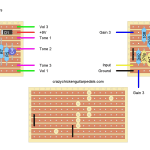 Lovepedal Purple Plexi On Stripboard
Lovepedal Purple Plexi On Stripboard
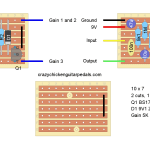 ZVEX Super Hard On On Stripboard
ZVEX Super Hard On On Stripboard
 Greer Amps Green Giant On Stripboard
Greer Amps Green Giant On Stripboard
 EartherQuaker Devices Speaker Cranker On Stripboard
EartherQuaker Devices Speaker Cranker On Stripboard
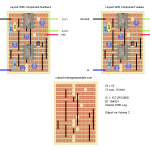 EarthQuaker Devices Acapulco Gold On Stripboard
EarthQuaker Devices Acapulco Gold On Stripboard
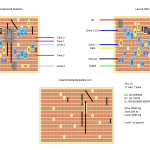 Ibanez Tube Screamer (TS808) On Stripboard
Ibanez Tube Screamer (TS808) On Stripboard
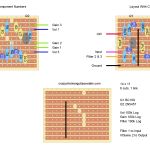 Lumpy’s Tone Shop Lemon Drop On Stripboard
Lumpy’s Tone Shop Lemon Drop On Stripboard
 Colorsound One Knob Fuzz On Stripboard
Colorsound One Knob Fuzz On Stripboard
 Marshall Bluesbreaker On Stripboard
Marshall Bluesbreaker On Stripboard
 How To Make A Distortion Pedal
How To Make A Distortion Pedal

